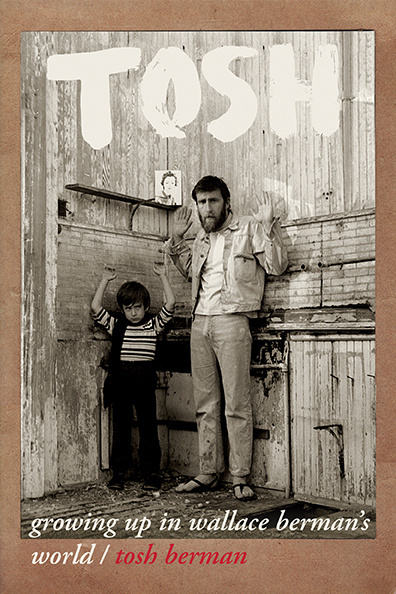Tosh: Growing Up in Wallace Berman’s World
By Tosh Berman
City Lights Books
$17.95
reviewed by Marc Olmsted
I first came across Wallace Berman’s artwork in an underground newspaper in the late ’60s – I can no longer remember which paper, but I do recall it was perhaps his most famous design, the high-contrast hand holding a transistor radio, and instead of the radio’s speaker, there was an image, something galactic as I remember.

Berman was experimenting with a Kodak verifax copier, the grandfather of photocopying, and had created an image that was able to stride both the hippie and punk art waves, certainly influencing all the punk poster art that is arguably still fresh even to this day. There was a quality of the decaying image of rephotography, of found detritus, as in his junk assemblages. As his son Tosh says so eloquently in this book, “To see the present, he needed the past, and through the past, he could see the present. Who knows? Maybe he could also see the future.” Indeed, there is no question that this image, often quadrupled with various different images where the transistor speaker would be, anticipated the smartphone with 100% accuracy.
Within a couple of years, I saw Berman’s photographic portrait of Michael McClure for McClure’s Ghost Tantras. McClure, nude, was covered with applied hair, looking very much like Bela Lugosi in The Island of Lost Souls. “Are we not men?” Still, I had no idea about Berman himself.
I became further aware of Berman through the 1995 Whitney Museum Beat show, and its “family tree” of influence at the back of the Beat Culture book it generated. It was also where I first say the work of Cameron, the witchy artist and follower of the magick path of Aleister Crowley. She would steal the screen from Anaïs Nin in Kenneth Anger’s Inauguration of the Pleasure Dome as the utterly mesmerizing Scarlet Woman, a movie I’d seen years earlier. The links just wouldn’t stop – my friendship with Beat artist Bob Branaman led me to Berman’s Photographs, where Bob was photographed, and my interest in Cameron led to the amazing book, Semina Culture: Wallace Berman and his Circle. Here I found the artwork of a number of my favorite actors as well, Dennis Hopper, Dean Stockwell and Russ Tamblyn, as well as recently befriended poet David Meltzer and long appreciated sculptor Edward Kienholz. In short, anyone hip in Southern California crossed paths with Berman, and many from around the world including Brian Jones and Allen Ginsberg – basically the 50s and 60s until his death in 1976 by a drunken driver.
Tosh Berman saw it all firsthand. He was the weird son of a weird father, and tells of his dad with great affection.
In all of this, Wallace Berman did his damnedest to avoid fame. Yet he’s on the album cover of Sgt. Pepper’s, next to Tony Curtis. “But my dad didn’t think too much of it…,” Tosh says…”He loved the Beatles, but this wasn’t an Earth-changing experience for him. His art took precedent.”
Tosh Berman originally announced the title of his book as Beat Boy. It is the culture he was raised in. Besides providing the only existing biography of his father, Tosh does an amazing thing – his prose echoes the mind of the young boy who experienced it – simple, direct, uncluttered. Tosh does such a good job that his own reveries, separate from his father, take on a fascinating time capsule of Marvel Comics and The Man from U.N.C.L.E., a time I also shared in Southern California born less than a year before his own 1954. His recollections of the news stand in Fairfax’s Farmer’s Market are just as vivid to me. His toy guns and spy board games echoed mine, as did the child’s eye impact of the assassination of JFK. Of course, my father was considerably straighter – my older brother was the bohemian of the family.
I also did not hang out with Brian Jones, just for starters.
Tosh enters junior high, then high school. The prose becomes more complex – the misadventures and nightmares of P.E. and elusively more mature girls all too familiar to my own experience of those same years. So whether talking about amazing figures of the avant garde or his own misfit routines, Tosh is a page turner.
Bob Branaman told me you might buy one of those quadruple transistor “smart phone” collages for $200 max while Berman was alive. An in-law of mine paid $10,000 for one and turned a profit of $40,000 without even hanging the image, the Hebrew lettering Berman adored considered “too Jewish” by my in-law’s Jewish wife.
Later I would stand in a Berman exhibit in a trendy art gallery in Los Angeles, watched like a hawk by the owner since I clearly couldn’t afford anything – and, at least in his mind, might grab something and run off with it. Everyone I turned I caught the art dealer’s gaze, as if saying “I’ve got my eye on you.” This included even examining the art book that had been generated for the showing.
It is not difficult to imagine what Berman would have made of any of this.
His son Tosh has written a great book – whatever your level of familiarity.
–Marc Olmsted
Photographs Reviews
I would stand in a Berman exhibit in a trendy art gallery in Los Angeles, watched like a hawk by the owner since I clearly couldn’t afford anything